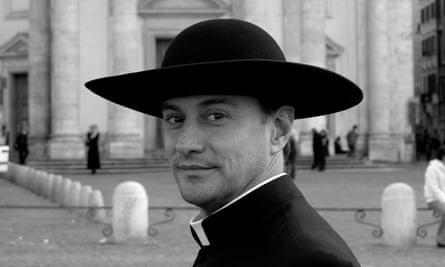If you’ve been to Rome, there’s a high chance you returned home with a slab of guanciale, two Fabriano notebooks and a copy of the hot priest calendar in your luggage.

The hot priest calendar is not its official name but, over the past two decades, the moniker has stuck (for reasons clear to anyone who’s seen it). Next year marks 20 years since the “calendario Romano” was first published, during which time it has grown from labour of love to cult souvenir.
Each month of the A4 flip calendar is represented by a nameless man of the cloth, photographed in black and white and usually against an ornate liturgical backdrop. Some wear a cappello romano (a type of wide-brimmed hat), others a clerical collar. December, the unequivocal favourite among calendar fans, rarely changes – he is pictured holding a copy of Le vie di Roma close to this cassocked chest. Broadly speaking, each “priest” is “hot”.
Much like the Pirelli calendar, published by the UK subsidiary of the Italian tyre manufacturing company, the connection between the images and the subject being promoted can feel, at times, tangential. But the motivation is pure, says the calendar’s 60-year-old Venetian photographer, Piero Pazzi. It is, he says, a “clean and honest product that simply advertises Rome and its most eloquent symbol: the Catholic clergy”.
But confession time: “They are not all priests, and they are not all from Italy,” says Pazzi, himself a Catholic, who has spent the past few decades visiting Rome and Seville to take these pictures. He uses a Fuji camera and photographs the men during trips to the cities during Easter. It’s a random process of selection, he explains, which means it can sometimes backfire: in one instance, an estate agent from Spain was mistaken for a priest and appeared as 2008’s “Father March” (he was wearing a black tunic at the time). But those photographed in Seville “are mostly acolytes of the countless brotherhoods that parade in the processions of Holy Week”, according to Pazzi.

During its mid-2010s heyday, the calendar is said to have sold about 75,000 copies a year and, despite a dip during the pandemic, it remains in high demand. The 2023 iteration has just gone on sale, costing around 10 euros depending on which shop or kiosk you buy it from – and is already fetching three times the price on eBay. Pazzi prefers not to estimate how many are sold now in case he gets it wrong, but he will go so far as to say that “in Rome, it is quite common”.
Rather than “photographer”, he uses the terms “archivist and archive researcher”; photography, he says, is just a hobby. His favourite subject is actually animals, especially cats – he has two of his own – and he also likes photographing gondoliers, a calendar of which predates that of the clergymen, but it’s the hot priest calendar that turned him into the Rankin of Catholicism. He says he created it to “educate the tourists who visit Rome by providing precise information on the Vatican state” – with facts and titbits written inside. He describes this as “very simple information, which the average tourist fully disregards”.
Still, the calendar is not without controversy. It has been criticised for repeating the same images year after year, although Pazzi disputes this claim. “Sometimes I replace the pictures,” he says. Looking through back issues, it appears to be true that February, May and July often change. Some of the repeated priests occasionally switch months, too.
Equally, accusations of Vatican propaganda have found their way on to various chat forums (the Vatican did not respond to requests for comment). Pazzi says the two are not linked: “I have never been reproached or called into question by any religious authority for the calendar,” he says, adding that, about 10 years ago, the Vatican confirmed that “it was not its official initiative but that of a private individual”.

The calendar itself is printed by a specialist “and distributed in an artisanal way”, he says, rather than being mass-produced. According to the calendar bumf, profits go to Snap, a support group for women and men abused by religious and institutional authorities.
Pazzi says the absence of the priests’ names is simply proof that neither the calendar, or its poster boys, are “products of vanity”. As to whether the calendar has led to a lifetime of fame, he thinks not. “These are photos of priests,” he says, “not photos of film stars.”
